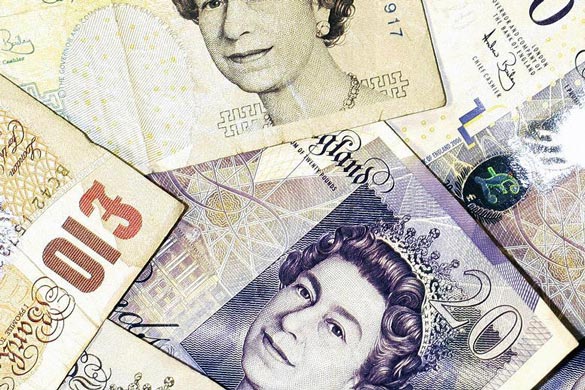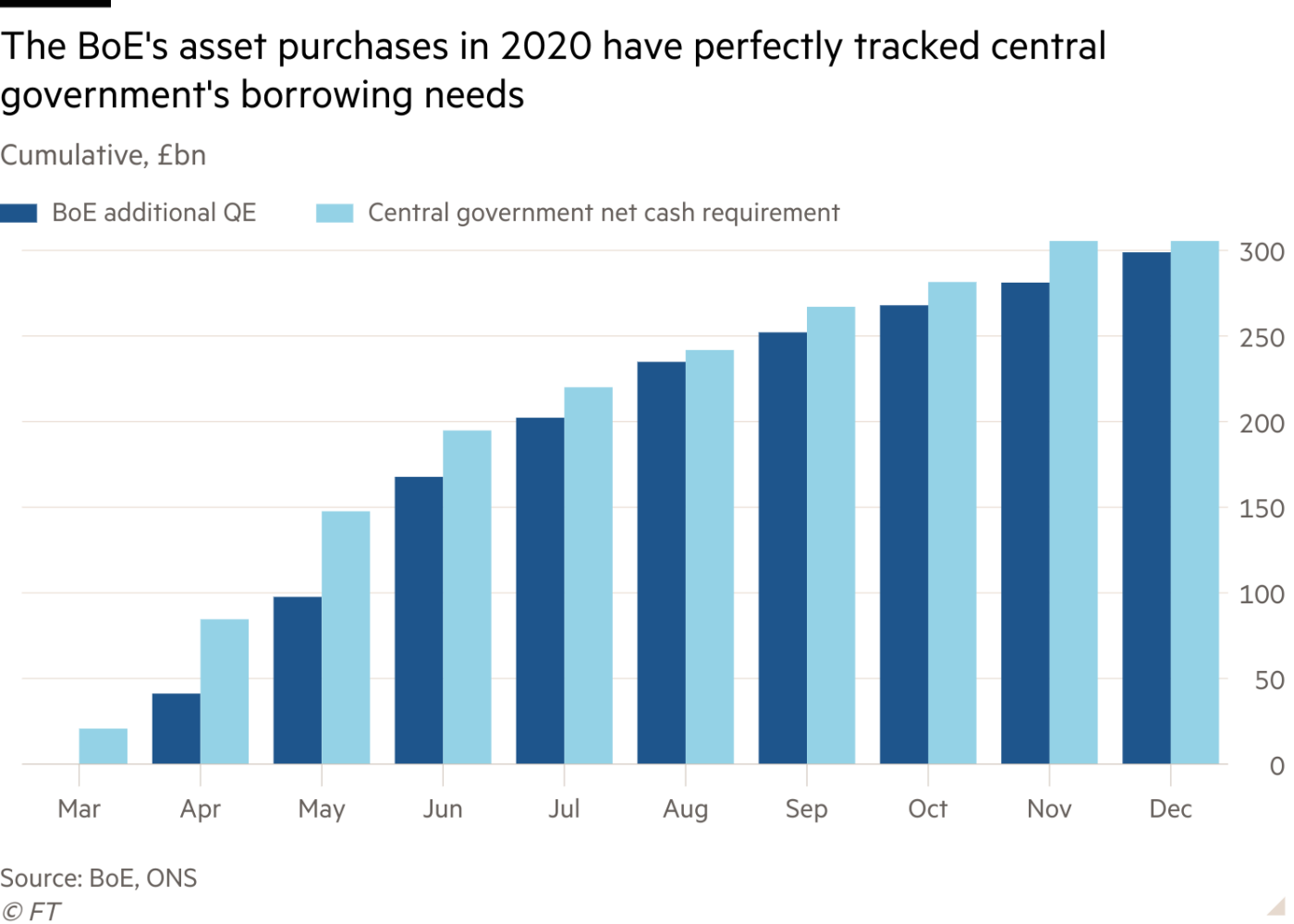Since the beginning of the surge in government spending in the UK caused by the Corona virus most of the new bonds issued to pay for all the deficit spending has ended up being bought up by the central bank. Is the Bank of England (BoE) implementing a policy based on Modern Monetary Theory (MMT)?
What is MMT? Modern Monetary Theory macroeconomic framework that says monetarily sovereign countries like the U.S., U.K., Japan, and Canada, which spend, tax, and borrow in a fiat currency they fully control, are not operationally constrained by revenues when it comes to government spending. Put simply, such governments do not rely on taxes or borrowing for spending since they can print as much as they need and are the monopoly issuers of the currency. Since their budgets aren’t like a regular household’s, their policies should not be shaped by fears of rising national debt.
MMT challenges conventional beliefs about the way the government interacts with the economy, the nature of money, the use of taxes, and the significance of budget deficits. These beliefs, critics say, are a hangover from the gold standard era and are no longer accurate, useful, or necessary.
The central idea of MMT is that governments with a fiat currency system under their control can and should print (or create with a few keystrokes in today’s digital age) as much money as they need to spend because they cannot go broke or be insolvent unless a political decision to do so is taken.
So rather than the government with it’s own fiat currency needing to collect tax revenues before spending it can print as much money as it wants to spend so long as the real economy is working at less than full capacity which is indicated by a low and not increasing rate of inflation. The role of taxes is to simply remove money from the economy to offset government spending so as to prevent inflation. As long as inflation is low and not increasing government’s can and should run any size defect they want as the low inflation clearly shows that the economy is working at less than full capacity. A tremendous benefit of MMT at times of very high government deficits is that is keeps yields on government bonds low (because it drastically increase the market demand for government bonds and hence causes their price to rise and thus their yields to fall) and lower yields means the cost of servicing all the new debt is drastically reduced.
Some say such spending would be fiscally irresponsible as the debt would balloon and inflation would skyrocket. But according to MMT, large government debt isn’t the precursor to collapse we have been led to believe it is, countries like the U.S. can sustain much greater deficits without cause for concern, and a small deficit or surplus can be extremely harmful and cause a recession since deficit spending is what builds people’s savings. MMT theorists explain that debt is simply money the government put into the economy and didn’t tax back. They also argue that comparing a government’s budgets to that of an average household is a mistake.
MMT has become increasingly popular on the progressive/Left side of politics in recent years. MMT seems to offer a way to to finance increased government spending without the need for automatic tax increases to pay for it, so it’s politically attractive for left parties who want to avoid campaigning on a probably unpopular tax increase platform. But perhaps the main driver for the wider acceptance of MMT has been the the outcome of the real world experiment in the decade after the 2008 Financial Crisis which saw massive increases in public deficit spending, accompanied by an equally large monetisation of a lot of of the new public debt when central banks effectively printed new money and bought up the newly issued government bonds, and which has been accompanied by flat or even falling inflation rates. This seemed to confirm some of the central pillars of MMT which is that the function of taxation is to control inflation and that printing money is OK as long as the the real economy is operating at less than full capacity.
MMT at the Bank of England
BoE bought an additional £450bn of gilts during the Covid-19 crisis in order to ease the government’s huge programme of borrowing by keeping debt servicing costs at rock bottom. The amount of bonds purchased under the BoE’s Quantitative Easing program has kept pace almost exactly with the government’s increase in deficit spending.
An FT survey of the 18 biggest players in the market for UK government bonds found the overwhelming majority believe that QE in its current incarnation works by buying enough bonds to mop up the amount the government issues and keep interest rates low.
“In this extraordinary year of gilt supply, the BoE has been the dominant buyer,” said Matthew Amis, of Aberdeen Standard Investments. “Without this significant support, bond yields would have risen significantly. Very simply, the gilt market could not have taken down the record £485bn supplied by the Debt Management Office to the market this year.”
The political issue that arises from all this is what to do longer term with all that government debt that now forms part of the balance sheet of the BoE. Traditional policy and theory says that the central bank must ‘unwind’ its position at some point soon after the immediate crisis period has ended, sell off its pile of bonds as they mature and thus ‘clean up’ its balance sheet. The problem, especially given the scale of the BoE bond holdings, is that will cause a surge in yields and thus a sharp increase in the costs of any further government borrowing. An progressive alternative is to simply leave the huge pile of government debt sitting harmlessly on the books of the BoE, perhaps by exchanging maturing bonds for a new special class of ultra low interest ‘perpetual bonds’ with maturity periods of say a 100 years, and then just forget about them. That’s more or less what was done with previous debt surges, the last of the long maturity World War One bonds weren’t paid off until 2010. Just let time, economic growth and the gradual erosion of the debt value through moderate inflation sort it all out over the next hundred years.



Could this buying up of Government debt be happening if the B of E was not independent?
Yes it could happen if the BoE was not independent. Exchanging the current BoE holdings of gilts into some sort of super low interest super long maturity perpetual bond would probably be easier to arrange if the bank was under government control.
Some are expecting China to run into difficulties after all the investment they carried out, resulting in acres of unoccupied tower blocks etc: Do the Chinese authorities do something similar to buying up their own debt?
The problem for the CCP is not handling the debt inside the financial system, they control the system very deeply, but rather the fact that for years the Chinese growth model has depended on very high levels of unproductive investment (I.e investment that cannot generate enough income to repay the debt incurred to make it). This model effectively generates GDP but not in the way that it is used as a measure in the rest of the world, it’s a measure economic activity but its loss making, and often useless (think empty cities, high speed trains and highways). The losses have to be passed to someone. And at the same time the CCP has to re-engineer the Chinese economy so as to move from investment driven growth to one based on domestic consumption. A very difficult thing because that means transferring a lot of income from some entities (party elites etc) to the people. And they need to do this without causing mass unemployment and an economic shock in a situation where China’s rigid political system does not feature many shock absorbers (for example sacking a government and installing an opposition in power is a shock absorber in the west). Currently the debt needed to generate any given amount of GDP growth is more than the growth it delivers so debt continues to grow faster than GDP. That cannot last for ever.
Comments on this entry are closed.